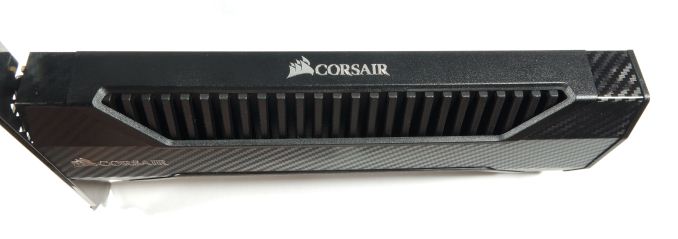The Corsair Neutron NX500 (400GB) PCIe SSD Review: Big Card, Big Pricetag
by Billy Tallis on August 16, 2017 10:00 AM ESTFinal Words
The Phison E7 NVMe SSD platform has provided us with a very interesting case study of the effects SSD controller firmware can have on the performance of drives with almost identical hardware. All Phison E7 drives on the market use Toshiba 15nm MLC NAND. The firmware has evolved significantly since the first retail release in the spring of 2016, but it has not produced an across the board improvement in performance.
On our ATSB tests of real-world desktop storage workloads, the NX500's best showing was on the Heavy test, the most write-intensive of the three. Digging deeper, our ATSB tests show the NX500 is generally slower than its siblings for writes, though often fastest of the three for reads. This is not where we expected its strengths to lie, though the benefits of the large spare area do show up in the relatively small performance hit the NX500 suffers when the tests are conducted on a full drive.
The NX500 is at its best with sustained high queue depths. It's reasonable for a drive with this much overprovisioning to take other measures to optimize for heavy workloads, but clearly the NX500 overshot any sensible consumer workload target. Even the heaviest desktop workloads don't reach QD32 very often, and their overall performance is determined primarily by how the drive behaves at low queue depths. At lower queue depths, the NX500 mostly fails to deliver.
Our synthetic tests mostly mirror the ATSB tests in showing lackluster write performance compared to how the NX500 ranks on the read speed tests. The sequential write speed of the NX500 is pretty good in the grand scheme of things, but the other two Phison E7 drives are slightly faster still.
The Corsair Neutron NX500 consistently scores poorly on power efficiency. Since it is a desktop-only drive and only consumes a few Watts at most, this is insignificant. One contributing factor is that the NX500 has twice as much DRAM as is typical for its flash capacity, providing a small but constant extra power draw that apparently doesn't do much for performance.
I suspect the firmware used on the NX500 borrows some more from Phison's enterprise SSD firmware than the Patriot Hellfire's firmware does. The Hellfire's performance clearly suffers greatly when the drive is full, more so than either of the other two Phison E7 drives we've tested, and more than most MLC SSDs. The Patriot Hellfire's ranking tends to be better on our short burst I/O tests at QD1 than on the sustained tests. All of those are common characteristics to see on consumer drives that sacrifice some high-end performance for the sake of better real-world performance. The Corsair Neutron NX500 isn't a clear loser on all of the real-world and low queue depth tests, indicating that it hasn't completely sacrificed consumer performance optimization in the pursuit of higher synthetic benchmark scores.
| 250-256GB | 400-512GB | 800-1024GB | 1.6-2TB | |
| Corsair Neutron NX500 | $319.99 (80¢/GB) | $649.99 (81¢/GB) | TBA | |
| Samsung 960 EVO | $142.84 (51¢/GB) | $234.00 (47¢/GB) | $477.99 (46¢/GB) | |
| Samsung 960 PRO | $299.99 (59¢/GB) | $579.99 (57¢/GB) | $1129 (55¢/GB) | |
| Intel SSD 600p | $165.59 (65¢/GB) | $212.99 (42¢/GB) | $355.00 (35¢/GB) | |
| WD Black | $109.99 (43¢/GB) | $198.98 (39¢/GB) |
While the tradeoffs of different Phison E7 firmwares are interesting, they're not too relevant to the current state of the market. All consumer PCIe SSDs using planar MLC NAND flash are squeezed between cheap TLC drives like the WD Black and Intel 600p, and Samsung's 960 EVO which offers better real-world performance than pretty much everything except the 960 PRO. At the moment, the price spread is a mere $35: from 39¢/GB for the WD Black up to 47¢/GB for the 960 EVO. It's hard to argue that there's any room for a product to carve out a niche somewhere in that small range. Based on performance alone, the Corsair Neutron NX500's MSRP is about twice what its actual retail price ought to be. But even with a massive price cut, the NX500 will need to rely on aesthetics and brand loyalty to sell.











45 Comments
View All Comments
damianrobertjones - Thursday, August 17, 2017 - link
Opens Amazon/ebay and types 'Toshiba XG5'. Nothing found. Oh well you've lost a possible sale Toshiba! Well done. (U.K.)mapesdhs - Thursday, August 17, 2017 - link
Get a 960 Pro instead, far better buy. My 512GB was only 249 UKP new.Or if you want to save some pennies, look for an SM951, SM961 or the older 950 Pro.
Billy Tallis - Thursday, August 17, 2017 - link
The XG5 is an OEM drive. They're selling every single one they can manufacture to companies like Dell. We'll see a retail counterpart eventually, once their BiCS3 manufacturing volume ramps up.wazoo42 - Thursday, August 17, 2017 - link
What happened to the performance consistency tests? Those were one of the primary reasons I went to Anand for SSD reviews.Billy Tallis - Thursday, August 17, 2017 - link
They'll be back eventually. I'm currently keeping the testbed busy around the clock with all the new drives that have arrived recently, plus re-testing older drives on the new 2017 test suite. The steady-state performance consistency test was the least realistic benchmark on the old 2015 test suite, so its replacement in the 2017 suite is my lowest priority. Once the testbed has some idle time, I'll go back and run the steady-state performance consistency tests on everything.In the meantime, the ATSB tests do have consistency scores in the form of 99th percentile latency, including broken down by reads and writes. I'm also considering adding some form of consistency score to the synthetic benchmarks that are already in this review.